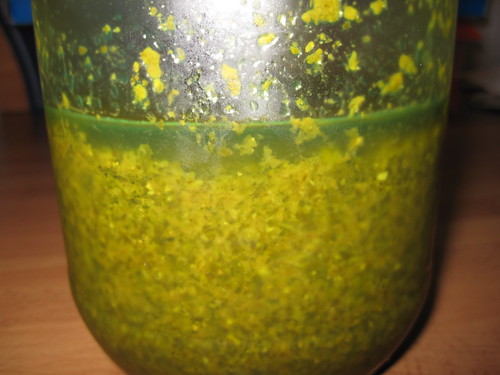
A couple of weeks ago, there was a fête in a nearby village. We've been going to it for many years, it's a nice walk across the fields, even on rainy Spring days. This time it was a very warm and sunny day and we'd also decided to do a longer walk before the fête started at lunchtime. After the really nice walk in an area we didn't think existed, we went straight for the book stall and there I found a small treasure - The World Encyclopedia of Spices. It's not exhaustive in any way and I've used most of the spices described in there, but the book has some good tips on how to determine the quality of different spices. The book also has a lot of recipes for different spice mixtures and pastes, which is the really interesting part of the book. What really caught my eye was a recipe for green masala. This is not a dry spice mixture, but a paste and looks very much like pesto, but smells and tastes quite differently. Lundulph is sold on it and has suggested we move into industrial production and sell it.
A key point to note is that this requires a little bit of planning, as there's pre-soaking and resting/cooling time required before it's ready for use. A spice mill or a clean coffee grinder is needed as well, for best results.
Ingredients
Makes about 400 ml
1 tsp fenugreek seeds
10 green cardamom pods
6 cloves
2 tsp ground turmeric
2 tsp salt
4 cloves of garlic
5 cm piece of fresh root ginger
50 g fresh mint leaves
50 g fresh coriander leaves
1 small green pepper
50 ml cider vinegar
60 ml grapeseed or sunflower oil
60 ml sesame oil, preferably not toasted
Method
- Soak the fenugreek seeds in some water overnight.
- The next day, bruise the cardamom and dry-fry in a thick-bottomed pan together with the cloves, stirring constantly, until their aroma develops. Then grind these finely and add the turmeric and salt and set aside.
- Peel the garlic and ginger and cut into chunks.
- Wash and cut the mint and coriander. Wash, cut and de-seed the pepper.
- Drain the fenugreek seeds and place in a food processor, along with the garlic, ginger, mint, coriander, pepper and vinegar. Blend until a smooth purée forms, then stir in the ground spice mixture.
- Mix together the grapeseed/sunflower oil and the sesame oil and heat it in a pan. Add the green paste, stir through to combine and cook for a few minutes. Remove from the heat and allow to cool completely.
- Transfer to a clean glass jar, level the top with the back of a spoon and if necessary top up with a little grapeseed/sunflower oil to ensure there is a thin layer of it covering the top surface to preserve the colour and freshness. Close tightly and store in the fridge.
I recommend once it's in the fridge, it's left for a further night to allow the flavours to develop even further. A key point is the keeping of a layer of fat on the surface - after each use, I've topped up with a little grapeseed oil, to make sure the paste is kept sealed.
Now this can be used as a marinade - I used about 100 ml for 600 g chicken breasts, which had been cut into bite-sized chunks and I coated them with the green masala and left overnight in the fridge. I fried the chicken in a little toasted sesame oil and served with steamed Jersey Royal potatoes and some green peas.
Last week we had intended to barbecue and I wanted to try this out on another batch of marinated chicken. Sadly it rained the whole day, so I ended up frying it again, but this time we had it with Lebanese flat bread and hummus, also very tasty.
My plan for the remaining paste is to try it on salmon, before baking as usual in aluminium foil. Then I'll have to make another batch, probably a double one and freeze in ice cube trays as the other recommendation for this paste was to add a tablespoon or two to a regular curry, especially if it has coconut milk in it.
Lundulph also requested that I modify the recipe so that it can be used as a dip as well. I'll have to think about that, as it's very strongly flavoured in its "raw" form. The other thing Lundulph was speculating about was whether dramatic changes can be made to a traditional pesto recipe, so as to get the same texture and colour, but completely cut out the parmesan cheese. Another one to think about.
 |
 |
No comments:
Post a Comment